Unit 6
Electrical Installations
It has one switch unit and one fuse unit. When the breaker is operated the contact to the switch is close and supply passes through the fuse unit to output. In fuse switch unit there is only fuse unit which acts as a switch. During operating the fuse unit closes the input and output of the breaker.
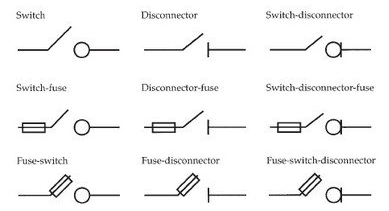
MCB is a switch which automatically turns off when the current flowing through it passes the maximum allowable limit. Generally, MCB is designed to protect against over current and over temperature faults. In MCB there are two contacts one movable and other non-movable. When the current exceeds the predefined limit, a solenoid forces the moveable contact to open and the MCB turns off, thereby stopping the current from flowing in the circuits.
It mainly consists of one bi- metallic strip, one trip coil and one hand operated on-off lever. The current in MCB flows from left side of circuit to bimetallic strip further going into the current coil, moving contact and at last through right side of circuit. When circuit is overloaded the bimetallic strip is overheated.
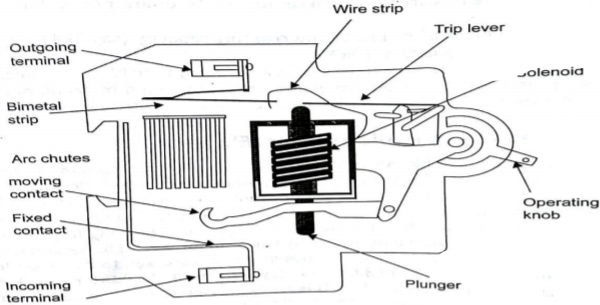
This deformation of bimetallic strip causes displacement in the latch. This displacement releases the spring through which the MCB is connected to the moving contact. This spring makes moving contact to open MCB.
The current coil or trip coil placed in such a manner that during SC faults, the MMF of that coil causes its plunger to hit the same latch point and force the latch to be displaced. Hence, the MCB will open in the same manner.
They are frequently used in domestic and industrial purposes. The MCB detects faults like switching, overload, short circuit protection and overload protection.
An Earth Leakage Circuits Breakers (ELCB) is a device used to directly detect currents leaking to earth from an installation and cut the power. There are two types of ELCBs:
(i) Voltage Earth Leakage Circuits Breaker (voltage -ELCB)
It consists of a relay coil; one end of that coil is connected to the metal body and other to the ground. When voltage on the equipment body rises to 50V (danger level) the current in the relay loop moves the relay contact by disconnecting the supply current and saves from electric shock.
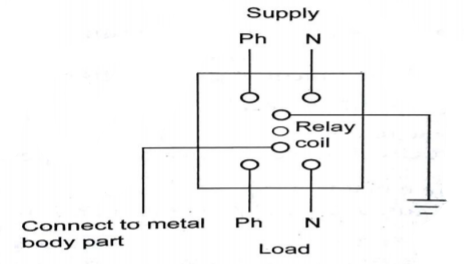
(ii) Current Earth Leakage Circuits Breaker (Current -ELCB)
It is mostly commonly used ELCB. It consists of transformer having two primary (neutral and line wire) windings and one secondary winding. In balanced condition there is no current in secondary because the neutral wire balances the current through the phase wire.
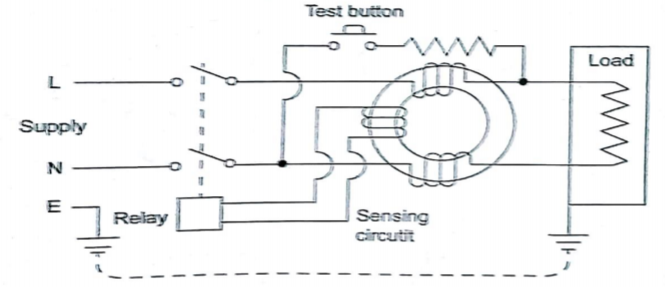
During fault a small current flow to ground causing imbalance between line and neutral currents. As a result of which current is induced in secondary winding. The sensing circuit connected to the secondary sends signal to the tripping system and the contact is tripped.
Moulded case circuits breakers are electromechanical devices which protect a circuit from over current and short circuits. They provide over current and short circuits protection for circuits ranging from 63A up to 3000 A. They are used for heavy duty applications as they have high current ratings. They provide electric feeder protection, capacitor bank protection, generator protection, welding applications, low current application that require adjustable trip setting and motor protection.
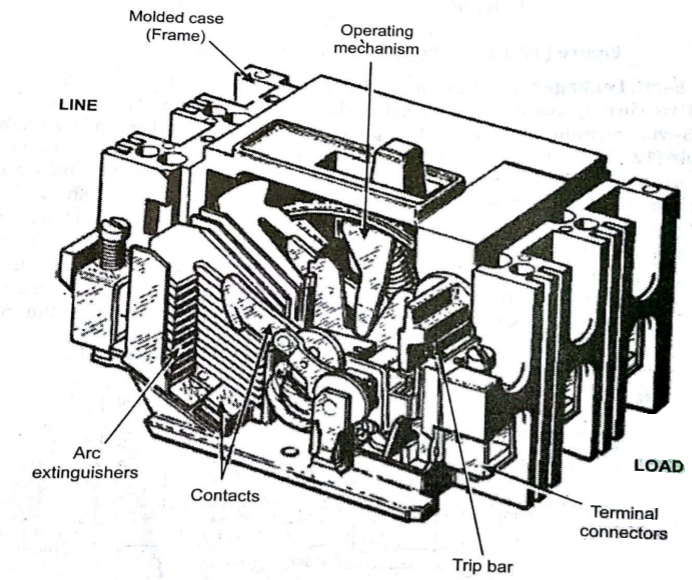
The are made up of heavy duty insulated plastic. MCCB has a bimetallic contact that expands and contacts when there is change in temperature. When current exceeds the adjustable trip value the contact gets heated and expands. The fault currents in MCCB can be interrupted immediately. Whenever a fault occurs, the extremely high current induces a magnetic field in a solenoid coil located inside the breaker – this magnetic induction trips a contact and current it interrupted
Types of Wiring
The wiresused for domestic or industrial wiring are classified into different groups as
(i) According to the conductor material used
(a) Copper conductor cables
(b) Aluminium conductor cable
(ii) According to number of cores
(a) Singles core cable (SCC)
(b) Double core or twin core cables (DCC)
(c) Three core cables
(d) four core cables
(e) Two cores with earth continuity conductor cables
(iii) According to type of insulation
(a) Vulcanized Indian rubber (VIR) insulated wires/cables
(b) Tough rubber sheathed (TRS) or cable tyre sheathed (CTS) cables
(c) Polyvinyl chloride (PVC) cables
(b) Lead sheathed cables
(e) Weather proof cables
(f) Flexible cords and cables
(g) XLPE cables
(IV) According to the voltage at which they are manufactured
(a) Low tension (LT) cables – up to 1000V
(b) High tension (HT) cables – up to 11kV
(c) Super tension (ST) cables – from 22-33kV
(d) Extra high tension (EHT) cables – from 33-66kV
(e) Extra super voltage cables – beyond 132 kV
Earthing
It means connecting electrical equipment to earth with very low resistance wire. This ensures safe discharge of electrical energy due to failure of the insulation line coming in contact with the casing, etc. Earthing brings the potential of the body of the equipment to zero.
The main purpose of Earthing is to protect the operating personnel from shock. Under unbalanced load maintain the line voltage. To avoid risk of fire due to leakage currents. For protecting the equipment.
Methods of Earthing:
(i) Plate earthing: A copper plate of dimension 60cm x 60cm x 3.18 is used for earthing. The plate is buried in ground and layered with coal and salt. Then water is poured to maintain the earth’s electrode resistance below maximum value. The earth wire is bolted to the earth plate.
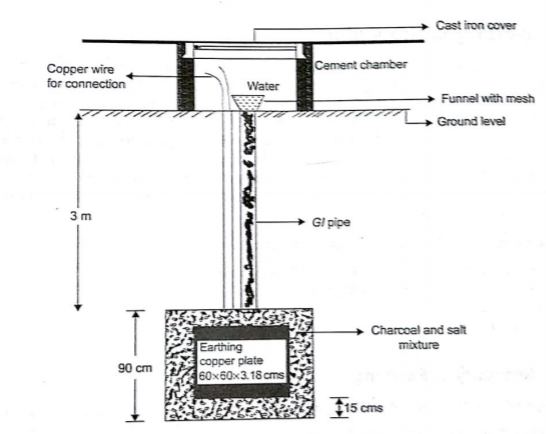
(ii) Pipe earthing:
The earth’s electrode made of galvanized iron pipe with holes on surface is placed upright in wet ground. In order to maintain the earth’s resistance, the pipe is filled with mixture of salt and coal. 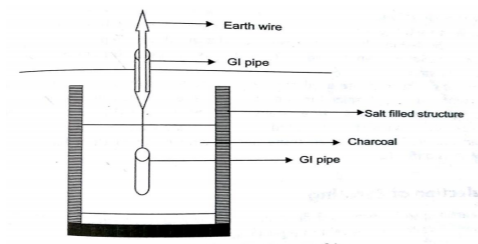
This system can carry larger leakage currents compared to plate earthing method.
(iii) Rod earthing: It is similar to pipe earthing method. A copper rod is buried upright in the earth manually or with pneumatic hammer. The length of embedded electrodes in soil reduces earth resistance to a desired level.
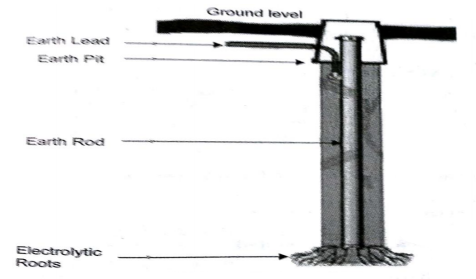
(iv) Strip or wire earthing: In this the earthing strip electrodes are buried in horizontal trenches of depth 0.5m. The copper plate or round conductors are used. The length of the conductor buried in the ground would give a sufficient earth resistance and this length should not be less than 15m. The electrodes shall be as widely distributed as possible in a single straight or circular trench radiating from a point. This type of earthing is used where the earth bed has a rocky soil and excavation work is difficult.
Application
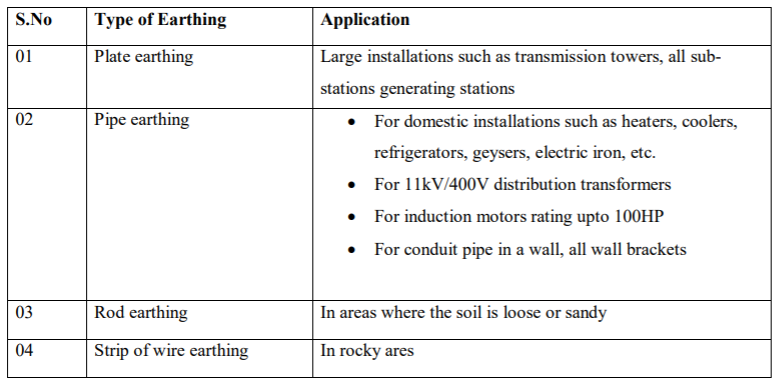
It converts chemical energy into electric energy.A combination of two or more voltaic cells is called as battery. Due to chemical reaction inside the cell voltage is produced. Electrodes are immersed in an electrolyte, which forces the electric charge to separate in the form of ions and free electrons.
i) Primary Batteries:
These are basically disposable batteries. They can be used only once. They are not rechargeable. EX. AA, AAA.
Types of Primary Batteries:
(a) Carbon- zinc dry cell: These are AA, AAA. They have zinc electrode as negative electrode and carbon as positive electrode. The output voltage of a single cell is about 1.5 V.
(b) Alkaline cell: It is AA type. It lasts long than carbon-zinc cell. It consists of a zinc anode and manganese dioxide cathode in an alkaline electrolyte
(c) Zinc chloride cell: These are heavy duty cells. It is modified zinc-carbon cell.
(d) Mercury cell: It is not used these days. It consists of zinc anode, mercury compound cathode and potassium or sodium hydroxide electrolyte.
(e) Silver oxide cell: This cell consists of a zinc anode, silver oxide cathode, and potassium of sodium hydroxide electrolyte. Normally used in cameras and watches.
(f) Lithium cell: It is light weight. It offers high output voltage. Two forms of 3V output in widespread use: (a) Lithium-sulfurdioxide(LiSO2 ). (b) Lithium- thionyl chloride.
Ii) Secondary Batteries:
These are rechargeable batteries. These are also called as storage batteries. They are rechargeable because the electric current reverses the chemical reaction inside the batteries that occurred during use. EX used in mobile phones, MP3 players.
Types of Secondary Cells:
(a) Lead-acid cell: It is most commonly used cell. It has porous lead anode and lead-oxide cathode. Used in automobile inverters. The output is of 2.1V.
(b) Nickel cadmium (NiCd) cell: It has Nickel hydroxide anode and cadmium hydroxide cathode. It delivers high current. It is used in cadmium hydroxide electrolyte. Used in alarm systems, TV equipment.
(c) Lithium-ion battery: It has graphite anode and lithium manganese dioxide cathode. The electrolyte used is mixture of lithium salts.
(d) Nickel-metal- hydride (NiMH) cell: They are used in power tools. They only have negative electrode, rest all similar to NiCd cells.
(e) Nickel-iron (Edison) cell: They have Nickel hydroxide anode and iron cathode with potassium hydroxide electrolyte. They are not in use now.
(f) Fuel cell: It converts chemical energy into water and produces electricity. They are used as source of DC power in space program. They are very efficient.
(g) Solar cell: They convert sunlight to electric energy. They are arranged in modules to form an array called solar array. An applied voltage higher than the voltage of one cell can be obtained by connecting cells in series. The total voltage available across the battery of cells is equal to the sum of the individual values for each cell. Parallel cells have the same voltage as one current capacity
The basic characteristics are:
i) Chemistry: Some batteries like lead, nickel and lithium need their own charger. So, the chemistry of the battery is important. It will not be properly charged if exact charger is not used.
Ii) Battery Capacity:It is the charge stored by the battery. y. The battery capacity represents the maximum amount of energy that can be extracted from the battery under certain specified conditions.The energy stored in a battery, called the battery capacity, is measured in either watt-hours (Wh), kilowatthours (kWh), or ampere-hours (Ahr). The most common measure of battery capacity is Ah, defined as the number of hours for which a battery can provide a current equal to the discharge rate at the nominal voltage of the battery.
Iii) Voltage:Any battery has a nominal voltage. It is important to check the correct nominal voltage before use.
Iv) Cold Cranking Amps(CCA):Every starter battery is marked with cold cranking amps, also abbreviated CCA. The number denotes theamount of amps that the battery is able to provide at -180C.
The measurement of electrical energy depends on power. But
Power= Voltage x Current
Energy = Power x Time
Joule is the smallest unit of energy. Watt-hour is the standard unit used for measurement of energy.
Energy in watt hours = Power in watts × Time in hours
Energy in kilowatt hours = Power in kilowatts × Time in hours
This kilowatt hour is board of trade (BOT) unit.
Que) A consumer uses a 10 kW geezer, a 6 kW electric furnace and five 100 W bulbs for 15 hours. How many units (kWh) of electrical energy have been used?
Sol : Given that Load – 1 = 10 kW
Geezer Load – 2 = 6 kW
Electric furnace Load – 3 = 500 watt (five 100 watt bulbs)
Total load = 10kW + 6kW + 0.5kW = 16.5kW
Time taken = 155 hours
Energy consumed = Power in kW × Time in hours = 16.5 × 15 = 247.5 kWh
1 unit = 1kWh.
So, the total energy consumption = 247.5 units If the cost per unit is 2.5, then the total cost of energy consumption ̇=247.5 × 2.5 = 618.75/-